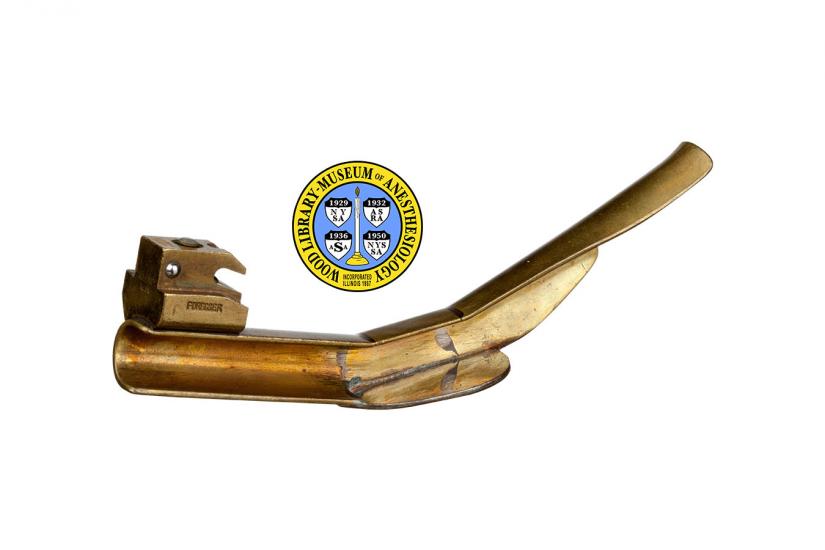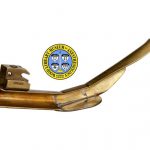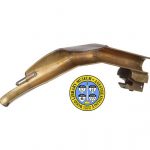Siker Laryngoscope
For surgeries that require general anesthesia, anesthesiologists often need to insert a plastic tube into a patient's trachea (wind pipe) to maintain an open airway and assist breathing. One of the tools used to do this is a laryngoscope, used to view the larynx (voice box), which is the opening to the trachea and lungs. The "blade" of the laryngoscope goes into the patient's mouth, acting as a tongue depressor and guide for the tube. In some cases, special laryngoscope blades that provide an indirect view are useful. This mirror blade was introduced in 1956 by Dr. Ephraim S. Siker (1926-2013). The example seen here was the inventor’s prototype. A copper jacket conducts heat away from the mirror, which minimizes fogging by the patient's breath. While this design helped to prevent injury in cases of difficult intubation, practice was needed in order to correctly follow the reversed image in the mirror.
Catalog Record: Siker Laryngoscope
Access Key: aiqc
Accession No.: 1994-08-01-1
Title: Siker [mirror laryngoscope prototype / designed by Ephraim S. Siker.]
Author: Siker, Ephraim S. (Rick), 1926-
Title variation: Alt Title
Title: Siker’s mirror laryngoscope blade.
Publisher: [Roslyn Heights, N.Y.] : Foregger, [1954-1955].
Physical Descript: 1 laryngoscope blade : brass, copper, stainless steel ; 5 x 3 x 15.5 cm.
Subject: Laryngoscopes – curved blades.
Subject: Difficult Airway – management.
Note Type: General
Notes: Title from the WLM descriptive name for the object and from Dr. Siker’s 1956
article introducing the new blade.
Note Type: Citation
Notes: Siker ES. A mirror laryngoscope. Anesthesiology. 1956;17(1):38-42.
Note Type: Physical Description
Notes: This description is based on the perspective of an anesthesiologist holding
the blade with a handle for immediate use; The spatula of the blade is
composed of three angulated sections welded to form an angle of approx. 135
degrees, and has a width of approx. 1.5 cm; If measured in a straight line
from the tip to the end of the fitting for the handle the blade measures
approx. 15.5 cm; If measured along the curve between the same two points it
measures approx. 17.5 cm; The flange curves around and a copper-plate is
welded to the flange so that a stainless-steel mirror on the copper-plate
faces up; The distance between the copper plate and the tip of the blade is
approx. 7.5 cm; The light-bulb is only 2.5 cm from the tip; Manufacture’s
marks are on the fitting for the handle:”SIKER”, “PATENT PENDING”, “USE LAMP
No. 1A”, and “FOREGGER”.
Note Type: Reproduction
Notes: Photographed by Mr. William Lyle, 7/14/2010.
Note Type: Historical
Notes: Early in his career Dr. Siker was enlisted to serve as an anesthesiologist
during the Korean war with the 4th Field Hospital in Taegu. Throughout his
career he was very active in the profession, teaching, speaking, and serving
on committees and in appointed and elected positions, including servings as
president of the American Society of Anesthesiologists in 1973, and the
American Board of Anesthesiology in 1983. The article describing Dr. Siker’s
mirrored laryngoscope blade was published in Anesthesiology in 1956. The aim
of Dr. Siker’s design was to prevent injury to the patient, especially in
difficult to intubate patients (Siker, 1956). The mirror was incorporated to
aid indirect visualization of the epiglottis. Copper was used as the plate
for the mirror to minimize fogging from the patient’s expirations. In
addition to describing the advantages that his blade provided, Dr. Siker
described the major disadvantages as well: The inverted image reflected in
the mirror required physicians to take time to practice with the blade in
order to use it well (Siker, 1956).
Note Type: Publication
Notes: Siker ES. Reflections: an autobiography. In: Fink BR, McGoldrick KE, eds.
Careers in Anesthesiology: Autobiographical Memoirs: volume III. Park Ridge,
Ill.: Wood Library-Museum of Anesthesiology; 1999:86-115.
Note Type: Exhibition
Notes: Displayed in the first floor, Northwest Highway, Wood Museum gallery (noted
7/14/2010); Selected for the redesigned WLM website; Moved to an ASA building
exhibit (the 2nd floor Airway Management exhibit) in October, 2010.



